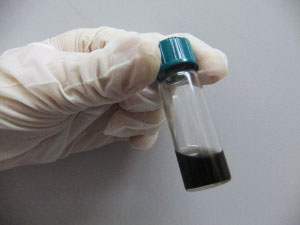| Nov 07, 2011 |
Photonics: Graphene's optical limitation
|
|
(Nanowerk News) Among the various remarkable properties of graphene that have attracted the attention of scientists and engineers is its high optical transparency in single sheet form. In suspension, however, graphene and its derivatives, such as carbon nanotubes and carbon black, begin to block light as the fluence of light increases. This optical limiting effect also has its applications, but so far the effect has only been realized at very high light fluences.
|
|
Geok-Kieng Lim, Lay-Lay Chua and colleagues from the National University of Singapore, DSO National Laboratories in Singapore and the University of Cambridge in the UK have now demonstrated a dramatic optical limiting effect at much lower fluences using dispersed sub-oxidized graphene ("Giant broadband nonlinear optical absorption response in dispersed graphene single sheets").
|
 |
| Sub-oxidized graphene dispersed in chlorobenzene.
|
|
The optical-limiting effect achieved using suspensions of carbon nanotubes or carbon black occurs through a 'damage' mechanism involving the development of microbubbles or microplasmas at high light fluence, which increases light scattering and breaks the optical transparency.
|
|
By functionalizing and dispersing single sheets of sub-oxidized graphene in 'heavy atom' solvents or certain polymer films, Lim, Chua and their colleagues found that their dispersions (see image) displayed optical limiting over a wide band of wavelengths at fluences 5–10 times lower than in previous carbon systems. Key to obtaining the excellent dispersions of graphene necessary to observe this light-blocking effect was the functionalization step, which involved modifying the graphene with surface alkyl chains to improved processability and enhance compatibility with the matrix material.
|
|
The researchers attribute this unusual optical limiting behavior to a new mechanism involving the formation of localized excited states through interactions with the environment. "This is a dramatic signature of the strong sensitivity of the two-dimensional electronic structure of graphene to its local environment," says Lim. Further measurements revealed that at high fluence, light absorption rises very quickly — a typical indication of localized excited states.
|
|
Beyond optical-limiting applications, the lessons learned in achieving excellent dispersions of graphene may themselves have broader uses. "The marriage of properties achieved in sub-oxidized graphene, where nanographene domains retain their optical and electronic properties surrounded by disordered boundaries that provide processability, opens up new applications for solution-processed graphene devices that are not possible for pure graphene alone," says Chua.
|

